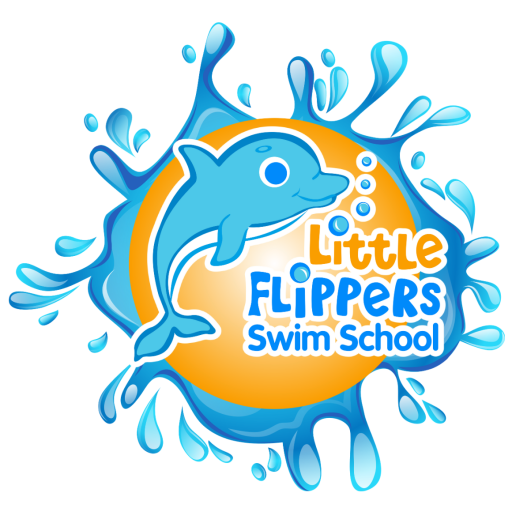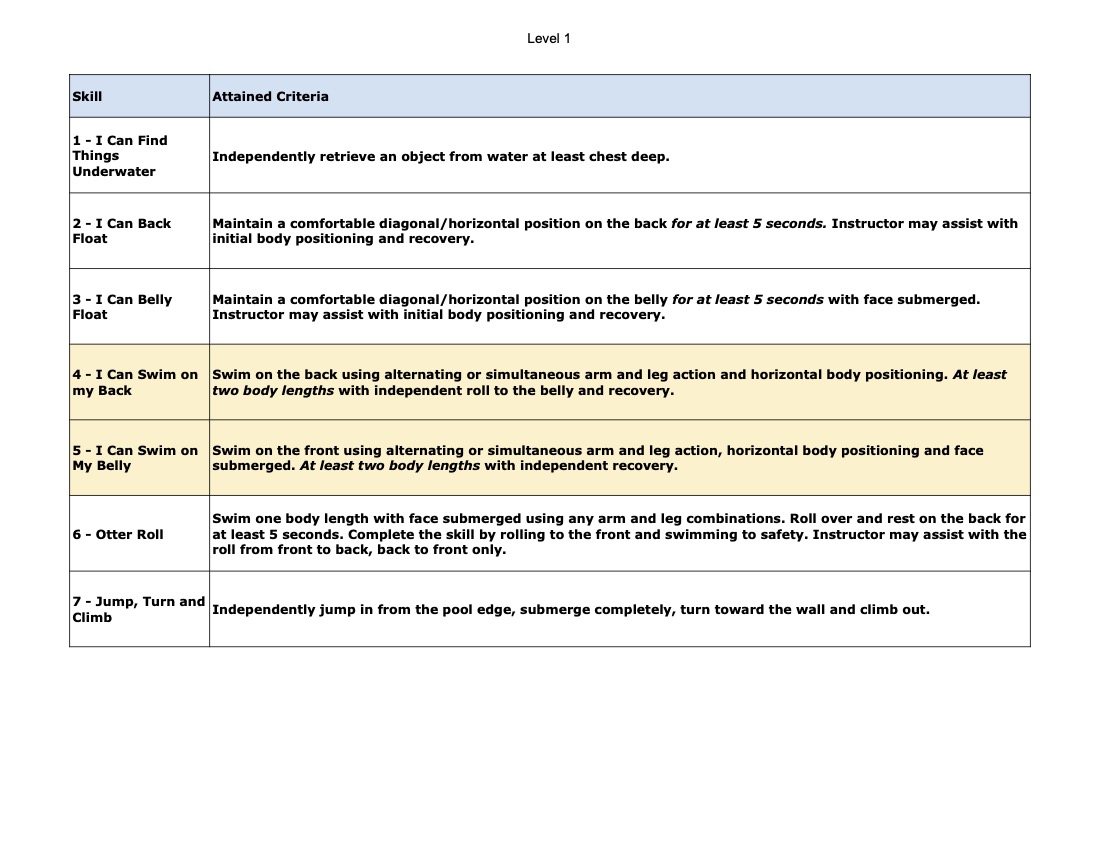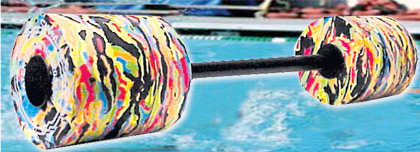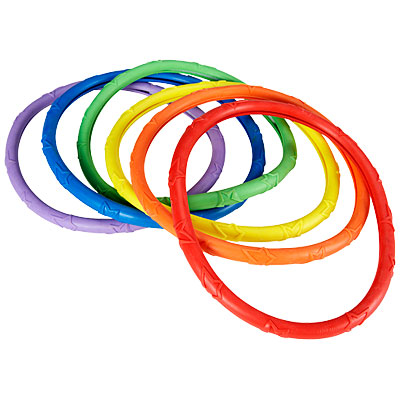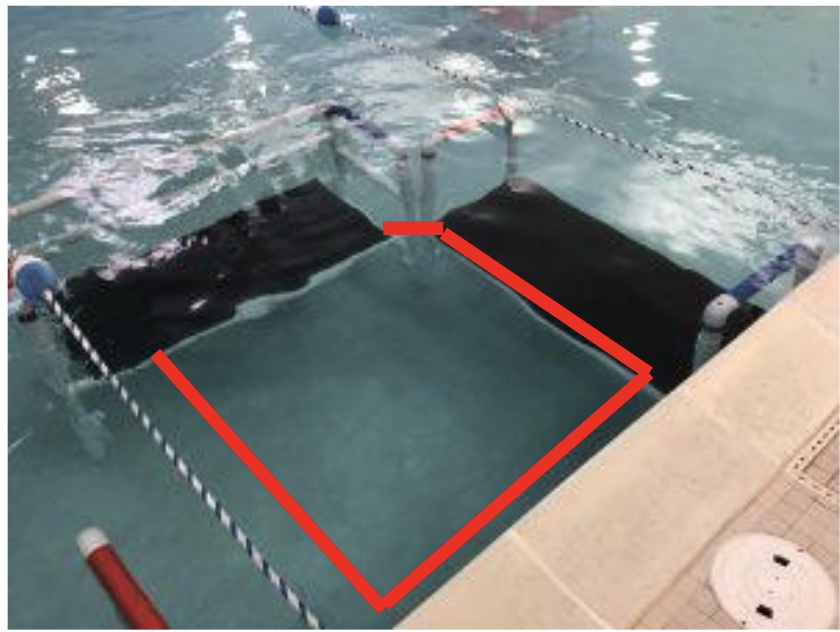Skill; I Can Find Things Underwater!
Criteria: To retrieve an object from water at least chest deep. Independently & without assistance from the instructor or dock.
Why: Refining Breath Control and gaining comfort and confidence while submerging.
How:
- Students stand in chest deep water on the dock, steps or pool bottom.
- Student takes a breath in and holds it.
- Student squats to submerge completely and reaches down for the object.
- Student resurfaces with the object.
Skill; I Can Float on My Back!
Criteria: Maintain a comfortable diagonal/horizontal position on the back for at least 5 seconds. Instructors may assist with initial body positioning and recovery.
Why: To increase comfort through Buoyancy and Balance.
How:
- Assist the student into a horizontal position on their backs as you support them under the head/upper body. Be sure to hold with a gentle touch and do not force them into position.
- Encourage them to hold their arms out to the side for balance and lay their head back until their ears are in the water. Legs may be straight, out to the sides or slightly bent, but there should be no movement.
- Encourage the students to look straight up while you support and/or position them for comfort.
- Once comfortable and confident, release your hold. Increase the number of seconds that you release to promote independent back floating
Skill; I Can Float on My Belly!
Criteria: Maintain a comfortable diagonal/horizontal position on the belly for at least 5 seconds with face submerged. Instructors may assist with initial body positioning and recovery.
Why: To increase comfort with Breath Control and Buoyancy and Balance.
How:
- Assist the student into a horizontal position on their belly as you support them under the shoulders. Be sure to hold with a gentle touch and do not force them into position.
- Encourages students to lower their chin into the water, hold their arms out to the sides and relax the legs back.
- Have students take a breath and then put their face in the water.
- Once comfortable and confident, release your hold. Increase the number of seconds that you release to promote independent belly floating.
Skill; I Can Swim on My Back
Criteria: Swim on the back using alternating or simultaneous arm and leg action and horizontal body positioning. At least two body lengths with independent roll to the belly and recovery.
Why: To introduce an independent Movement on the Back!
How: Children learn the basics for finning* arm movements and kicks as a foundation for learning strokes. Rather than trying to teach any specific stroke qualities, guide them in exploring arm and leg movements that are propulsive and create forward movement and maintain their head above water
*Finning, a pushing motion with the arms, is a basic skill for creating movement on the back (tell kids to “wave” to their toes).
Practice Finning;
1. Move into a back float position with your head back and your arms at your sides, palms
down. Your hands are relaxed and under the surface of the water.
2. Bend your elbows and slowly move your hands away from your sides.
3. Flex your wrists and push the water toward your feet using short strokes. Your arm
movements can be simultaneous or slightly alternating.
Skill; I Can Swim on My Belly
Criteria: Swim on the front using alternating or simultaneous arm and leg action, horizontal body positioning, and face submerged. At least two body lengths with independent recovery.
Why: To introduce an independent Movement on the Belly!
How: Children learn the basics for alternating (paddles) and simultaneous (scoops) arm movements and kicks as a foundation for learning strokes. Rather than trying to teach any specific stroke qualities, guide them in exploring arm and leg movements that are propulsive and create forward movement.
Skill; I Can Otter Roll
Criteria: Swim one body length with face submerged using any arm and leg combinations. Roll over and rest on the back for at least 5 seconds. Complete the skill by rolling to the front and swimming to safety. Instructors may assist with the roll from front to back, back to front only.
Why: Introducing the Safety skill of rolling over (with a little guidance).
How:
- Encourage the student to push off the dock, steps or pool bottom and swim a short distance.
- Assist them by rotating their shoulders until they have rolled to their back.
- Release your support and encourage the student to pause and float for at least 5 seconds.
- Assist the student with rolling to their belly in the same direction that they came to arrive on their back.
- Release your hold and allow them to swim the remainder of the way to the wall, dock, or steps.
Skill; I Can Jump, Turn and Climb!
Criteria: Independently jump in from the pool edge, submerge completely, turn toward the wall and climb out.
Why: Introducing the Safety skill of returning to the wall after entering the water.
How:
- Instruct the student to stand up at the edge of the pool with ten toes curled over the edge.
- Position yourself at the side with one hand behind their back as you encourage them to jump out and away from the edge and into the water.
- Cue them to turn around and swim back toward the wall and grab on.
- Once the are secure on the wall cue them to climb out of the pool using the elbow, elbow, belly knee technique.
Skills Criteria
Suggested Props
- Cups
- Small Barbells
- Large Barbells
- Sinking Rings
Dock Arrangements
In a Corner – 1 dock for continuous movement. Move to the Wall, Monkey Walk Around the Corner and walk across the dock.
In a Lane – 2 docks for continuous movement. Move to the wall, monkey walk to the dock, walk across one dock then slide to the next and walk across again.
